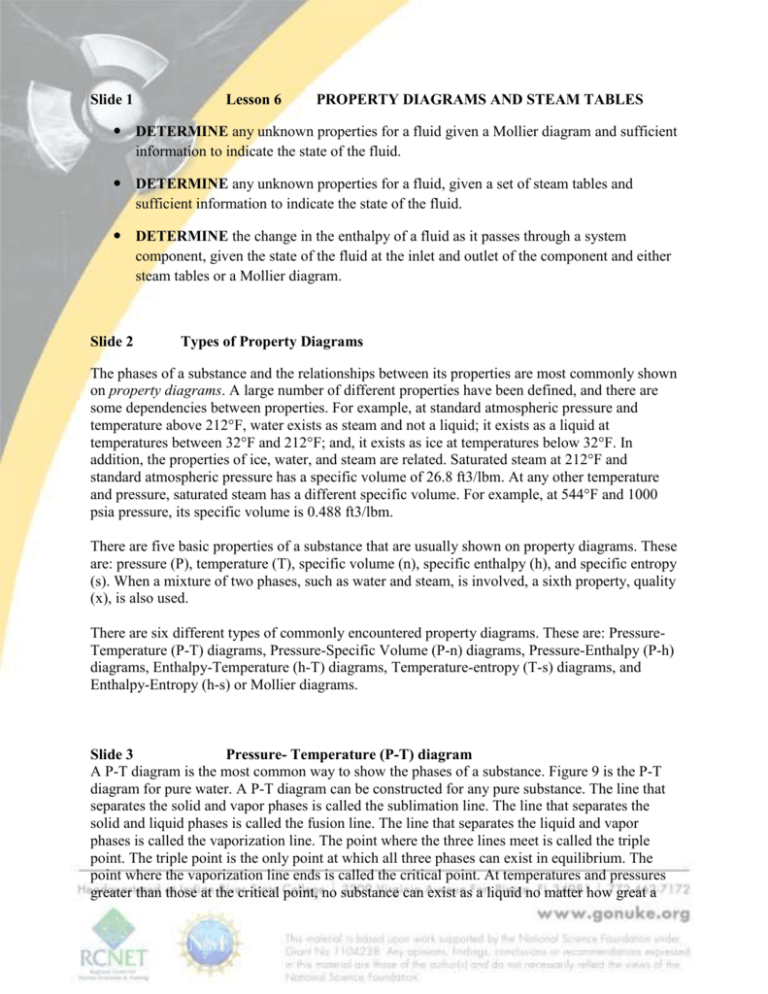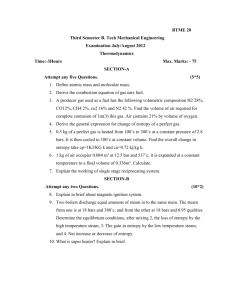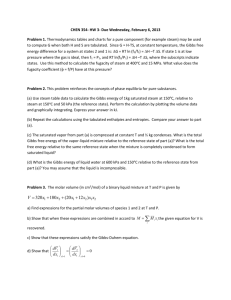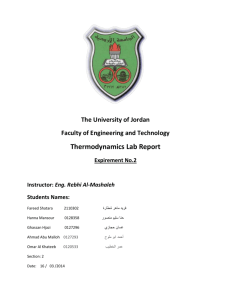Narrative Property Diagrams and Steam Tables
advertisement

Slide 1 Lesson 6 PROPERTY DIAGRAMS AND STEAM TABLES DETERMINE any unknown properties for a fluid given a Mollier diagram and sufficient information to indicate the state of the fluid. DETERMINE any unknown properties for a fluid, given a set of steam tables and sufficient information to indicate the state of the fluid. DETERMINE the change in the enthalpy of a fluid as it passes through a system component, given the state of the fluid at the inlet and outlet of the component and either steam tables or a Mollier diagram. Slide 2 Types of Property Diagrams The phases of a substance and the relationships between its properties are most commonly shown on property diagrams. A large number of different properties have been defined, and there are some dependencies between properties. For example, at standard atmospheric pressure and temperature above 212°F, water exists as steam and not a liquid; it exists as a liquid at temperatures between 32°F and 212°F; and, it exists as ice at temperatures below 32°F. In addition, the properties of ice, water, and steam are related. Saturated steam at 212°F and standard atmospheric pressure has a specific volume of 26.8 ft3/lbm. At any other temperature and pressure, saturated steam has a different specific volume. For example, at 544°F and 1000 psia pressure, its specific volume is 0.488 ft3/lbm. There are five basic properties of a substance that are usually shown on property diagrams. These are: pressure (P), temperature (T), specific volume (n), specific enthalpy (h), and specific entropy (s). When a mixture of two phases, such as water and steam, is involved, a sixth property, quality (x), is also used. There are six different types of commonly encountered property diagrams. These are: PressureTemperature (P-T) diagrams, Pressure-Specific Volume (P-n) diagrams, Pressure-Enthalpy (P-h) diagrams, Enthalpy-Temperature (h-T) diagrams, Temperature-entropy (T-s) diagrams, and Enthalpy-Entropy (h-s) or Mollier diagrams. Slide 3 Pressure- Temperature (P-T) diagram A P-T diagram is the most common way to show the phases of a substance. Figure 9 is the P-T diagram for pure water. A P-T diagram can be constructed for any pure substance. The line that separates the solid and vapor phases is called the sublimation line. The line that separates the solid and liquid phases is called the fusion line. The line that separates the liquid and vapor phases is called the vaporization line. The point where the three lines meet is called the triple point. The triple point is the only point at which all three phases can exist in equilibrium. The point where the vaporization line ends is called the critical point. At temperatures and pressures greater than those at the critical point, no substance can exist as a liquid no matter how great a pressure is exerted upon it. Slide 4 Pressure-Specific Volume (P-v) Diagram A P-n diagram is another common type of property diagram. The P-n diagram for pure water is shown. A P-n diagram can be constructed for any pure substance. A P-n diagram is different from a P-T diagram in one particularly important way. There are regions on a P-n diagram in which two phases exist together. In the liquid-vapor region shown, water and steam exist together. For example, at point A, water with a specific volume (nf), given by point B, exists together with steam with a specific volume (ng), given by point C. The dotted lines are lines of constant temperature. The quality of the mixture at any point in the liquid-vapor region can be found because the specific volumes of water, steam, and the mixture are all known. The quality can be found using the following relationship. n = xng + (1 - x)nf X = (n- nf ) / (ng - nf) = (n - nf) / nfg where: n = specific volume of the mixture (ft3/lbm) x = quality of the mixture (no units) ng = specific volume of the vapor (ft3/lbm) nf = specific volume of the liquid (ft3/lbm) nfg = specific volume change of vaporization (ft3/lbm) or vfg = vg - vf Slide 5 Pressure-Enthalpy (P-h) Diagram A P-h diagram exhibits the same features as a P-n diagram. The P-h diagram for pure water is shown. A P-h diagram can be constructed for any pure substance. Like the P-n diagram, there are regions on a P-h diagram in which two phases exist together. In the liquid-vapor region water and steam exist together. For example, at point A, water with an enthalpy (hf), given by point B, exists together with steam with an enthalpy (hg), given by point C. The quality of the mixture at any point in the liquid-vapor region can be found using the following relationship. h = xhg + (1 - x)hf x = (h - hf) / hfg where: h = specific enthalpy of the mixture (Btu/lbm) x = quality of the mixture (no units) hg = specific enthalpy of the saturated vapor (Btu/lbm) hf = specific enthalpy of the saturated liquid (Btu/lbm) hfg = specific enthalpy change of vaporization (Btu/lbm) or hfg = hg - hf Slide 6 Enthalpy-Temperature (h-T) Diagram An h-T diagram exhibits the same features as on the previous property diagrams. The h-T diagram for pure water is shown. An h-T diagram can be constructed for any pure substance. As in the previous property diagrams, there are regions on the h-T diagram in which two phases exist together. The region between the saturated liquid line and the saturated vapor line represents the area of two phases existing at the same time. The vertical distance between the two saturation lines represents the latent heat of vaporization. If pure water existed at point A on the saturated liquid line and an amount of heat was added equal to the latent heat of vaporization, then the water would change phase from a saturated liquid to a saturated vapor (point B), while maintaining a constant temperature. As shown in Figure 12, operation outside the saturation lines results in a subcooled liquid or superheated steam. The quality of the mixture at any point in the liquid-vapor region can be found using the same relationship as shown for the P-h diagram. x = (h - hf) / hfg Slide 7 Temperature-Entropy (T-s) Diagram A T-s diagram is the type of diagram most frequently used to analyze energy transfer system cycles. This is because the work done by or on the system and the heat added to or removed from the system can be visualized on the T-s diagram. By the definition of entropy, the heat ransferred to or from a system equals the area under the T-s curve of the process. The T-s diagram for pure water is shown. A T-s diagram can be constructed for any pure substance. It exhibits the same features as P-u diagrams. In the liquid-vapor region in Figure 13, water and steam exist together. For example, at point A, water with an entropy (sf) given by point B, exists together with steam with an entropy (sg) given by point C. The quality of the mixture at any point in the liquid-vapor region can be found using the following relationship. s = xsg + (1 - x) / sf x = (s - sf ) / sfg where: s = specific entropy of the mixture (Btu/lbm-°R) x = quality of the mixture (no units) sg = specific entropy of the saturated vapor (Btu/lbm-°R) sf = specific entropy of the saturated liquid (Btu/lbm-°R) sfg = specific entropy change of vaporization (Btu/lbm-°R) or sfg = sg - sf Slide 8 and 9 Enthalpy-Entropy (h-s) or Mollier Diagram The Mollier diagram is a chart on which enthalpy (h) versus entropy (s) is plotted. It is sometimes known as the h-s diagram and has an entirely different shape from the T-s diagrams. The chart contains a series of constant temperature lines, a series of constant pressure lines, a series of constant moisture or quality lines, and a series of constant superheat lines. The Mollier diagram is used only when quality is greater than 50% and for superheated steam. Slide 10 -15 Steam Tables Steam tables consist of two sets of tables of the energy transfer properties of water and steam saturated steam tables and superheated steam tables. Portions of the tables are shown in Figure A-2 of Appendix A. Both sets of tables are tabulations of pressure (P), temperature (T), specific volume (), specific enthalpy (h), and specific entropy (s). The following notation is used in steam tables. Some tables use v for (specific volume) because there is little possibility of confusing it with velocity. T = temperature (°F) P = pressure (psi) = specific volume (ft3/lbm) f = specific volume of saturated liquid (ft3/lbm) g = specific volume of saturated vapor (ft3/lbm) fg = specific volume change of vaporization (ft3/lbm) h = specific enthalpy (Btu/lbm) hf = specific enthalpy of saturated liquid (Btu/lbm) hg = specific enthalpy of saturated vapor (Btu/lbm) hfg = specific enthalpy change of vaporization (Btu/lbm) s = specific entropy (Btu/lbm-°R) sf = specific entropy of saturated liquid (Btu/lbm-°R) sg = specific entropy of saturated vapor (Btu/lbm-°R) sfg = specific entropy change of vaporization (Btu/lbm-°R) Sh = number of degrees of superheat (°F) The saturated steam tables give the energy transfer properties of saturated water and saturated steam for temperatures from 32 to 705.47°F (the critical temperature) and for the corresponding pressure from 0.08849 to 3208.2 psi. Normally, the saturated steam tables are divided into two parts: temperature tables, which list the properties according to saturation temperature (Tsat); and pressure tables, which list them according to saturation pressure (Psat). Figure A-2 shows a portion of a typical saturated steam temperature table and a portion of a typical saturated steam pressure table. The values of enthalpy and entropy given in these tables are measured relative to the properties of saturated liquid at 32°F. Hence, the enthalpy (hf) of saturated liquid and the entropy (sf) of saturated liquid have values of approximately zero at 32°F. Most practical applications using the saturated steam tables involve steam-water mixtures. The key property of such mixtures is steam quality (x), defined as the mass of steam present per unit mass of steam-water mixture, or steam moisture content (y), defined as the mass of water present per unit mass of steam-water mixture. The following relationships exist between the quality of a liquid-vapor mixture and the specific volumes, enthalpies, or entropies of both phases and of the mixture itself. These relationships are used with the saturated steam tables.









